Study on the Mechanism of Shimian Granules (SMG) against Depression via Regulating Circadian Rhythms
Xu He, Yan Shen, Yan-na Ma, Zhen-liang Hui, Jun Chen*, Shao-wei Li*
1Department of First College for Clinical Medicine, Shanxi University of Chinese Medicine, Xianyang, 712000, China.
2Department of Encephalopathy, Shanxi Provincial Hospital of Chinese Medicine, Xian, 710003, China.
Abstract: Background: According to the World Health Organization, about 350 million people worldwide are suffering from depression.It's reported that depression has been linked to several circadian rhythm perturbations,suggesting a disruption of the circadian clock system in affective disorders.The present study investigates the possible molecular mechanism of Shimian granules (SMG) in treating depression via restoring disrupted circadian rhythms.Method: Firstly, network pharmacology approach was used to identify the compounds and potential targets of SMG in TCMIP and BATMAN-TCM database.Secondly, the differential expression genes were obtained by gene expression profiling in GEO database (GSE56931, GSE98793).Further, protein-protein interactions (PPI) network was used to screen out core targets by STRING v11.Moreover, functional enrichment was carried out in DAVID database.Conclusively, the "herbs-compounds-targets-pathways" network was established to explore the mechanism of SMG in the treatment of depression.Result: It was found out that 65 compounds, 18 targets and three pathways contributed to SMG in treating depression by regulating disrupted circadian rhythms, which might relate to core targets TNF, IL10, VDR in cAMP and calcium signaling pathway.Conclusion: Network pharmacology combined with gene expression profiling exhibited a powerful means to investigate the possible mechanism of formula, which contributes to theoretical basis for further study of SMG in the treatment of depression
Keywords: depression; circadian rhythms; molecular mechanism; Shimian Granules (SMG); network pharmacology; gene expression profiling
Introduction
Circadian rhythm (wake-up cycle) is nearly 24-hour oscillations, which exists in almost all physiological processes of the human brain and body [1].The suprachiasmatic nucleus (SCN) acts as the central pacemaker in the hypothalamus, setting the timing of rhythms via regulating wake-up cycle, neuronal activity and hormonal signals [2].The strong relationship was found between depression and work schedules among 11,450 shift nurses, especially those with fast and uncertain rotation schedules [3].Similarly, 14,000 electronics workers were enrolled to compare the incidence rate of insomnia, depression, and suicidal ideation between day workers and shift workers, which indicated that the shift workers had higher rates [4].Further, disrupted circadian rhythms indirectly change the mood, impair learning, and increase the risk of developing mental illness.A cross-sectional study enrolled 522 workers to evaluate the contribution of daily sleep habits and depressive symptoms,suggesting an association between poor sleep and symptoms of deep depression [5].More importantly,disrupted circadian may promote susceptibility to or progression of certain diseases, within a developmental context, especially for depression [6, 7].In addition,the depressive symptoms may also occur in seasonal patterns.A study comprised 231,824 hospitalizations supported seasonal variation in MDD symptoms [8].And the disturbing 5-HT system might be one of the reasons [9].As a kind of mental illness, depression is mainly manifested as a state of depression sadness lasting for more than two weeks due to complex reasons [10], which characteristics of high incidence,recurrence and disability.As far as the current research is concerned, melatonin receptor agonists are the first choice for the treatment of depression with disrupted circadian rhythms, which have specific clinical efficacy, but still remain inevitable limitations.Longterm exogenous supplements may lead to inhibition of self-secretion and withdrawal reaction.At the same time, sexual dysfunction occurred due to suppressed hypothalamus-pituitary-gonads axis (HPGA) [11, 12].Thus, it is necessary to find safe and effective treatment for depression via regulating disrupted circadian rhythms.
Traditional Chinese medicine (TCM) has a long history in the treatment of depression [13], and its clinical application is more and more extensive with the advantage of good curative effects and fewer side effects.Shimian granules (SMG) is an improved prescription of Danzhi Xiaoyao Powder, which consist of Mu dan pi(Moutan Cortex), Zhi zi(Gardeniae Fructus), Huang qin (Scutellariae Radix), Chai hu(Bupleuri Radix), Yu jin (Curcumae Radix), Fu ling(Poria),Bai shao (Paeoniae Radix Alba),Bai zhu(Atractylodis Macrocephalae Rhizome), Suan zao ren(Ziziphi Spinosae Semen), Bai zi ren (Platycladi Semen),Yuan zhi (Polygalae Radix),Chuan xiong(Chuanxiong Rhizoma), Dang gui (Angelicae Sinensis Radix), Mu li (Ostreae Concha), He huan pi (Albiziae Cortex), Gan song(Nardostachyos Radix Et Rhizoma),Long gu (Os Draconis).SMG has been used in clinic for more than ten years in the improvement of mood,with the effect of soothing liver, nourishing the heart to tranquilize.A previous double-blind, randomized,placebo-controlled clinical trial has proved that SMG may improve sleep and affective state in shift nurses,which are associated with changes in concentrations of salivary cytokines [14].Whereas, the mechanism is still unclear.And the research of SMG still focused on clinical observation [15], lacking basic research on the material basis and mechanism.Identifying the mechanism of SMG may have important implications for the treatment of depression, and knowing the causal relationships between rhythm dysfunction and psychiatric disorders may have crucial implications for the treatment of mood disorders.
In this study, integrated pharmacological analysis and gene expression profiling were introduced to explore the mechanism of SMG against depression by restoring disrupted circadian.Differentially gene expression was obtained from transcription profile datasets of sleep deprivation induced depression.The mechanism of SMG in the treatment of depression was revealed with the help of an integrated pharmacological method.Our study aims to illustrate the material basis and molecular mechanism of SMG against depression by restoring disrupted circadian, exploring the possibilities of SMG for circadian rhythm, and providing a theoretical basis for upgrading.
2 Method and Materials
2.1 Identification of compounds for SMG
The identification of compounds for SMG was collected by Integrative Pharmacology-based Research Platform of Traditional Chinese Medicine (TCMIP,http://www.tcmip.cn/TCMIP/index.php/) v 2.0 [16] and Bioinformatics Analysis Tool for Molecular mechanism of Traditional Chinese Medicine (BATMAN-TCM,http://bionet.ncpsb.org.cn/batman-tcm/) [17].
2.2 Target fishing of chemical compounds for SMG
The targets were predicted by BATMAN-TCM and MedChem Studio (version 3.0).The core idea of BATMAN-TCM is to estimate potential compoundtarget interactions according to their similarity to the known compound-target interactions.MedChem was a software embeded in the TCMIP platform.The principle of MedChem Studio is an efficient drug similarity search tool to identify known drugs with high structural similarity to herbal ingredients [18].When the Tanimoto score of the known drug and the tested compound is greater than 0.6, it is considered that the target of the tested compound is consistent with that of a known drug.
2.3 Screening targets of depression
GEO database (https://www.ncbi.nlm.nih.gov/geo/) was applied to identify the risk targets of depression with disrupted circadian rhythms [19], which is the largest and most comprehensive public gene expression data resource.The transcription profile samples of circadian rhythms were obtained from GEO databases.The GEO series came to GSE56931, including 7 control individuals who were resistant to sleep deprivation and 7 patients who were sensitive to sleep deprivation[20].Additionally, GSE98793 was selected to reveal depression-related DEGs, and this transcription profile contains 128 depressive samples and 64 healthy controls [21].R software (version 4.0.3, https://www.r-project.org/) was used in data mining and statistical analyses via Limma Packages [22].The genes with P-value< 0.05 were considered as DEGs, and genes with log fold change (log FC) > 0 were considered as upregulated, log FC < 0 were considered down-regulated.Consequently, the common DEGs of GSE56931 and GSE98793 were regarded as the potential targets of depression with disrupted circadian rhythms.
2.4 Venn analysis
The common targets of disease-related genes and compound-targets of SMG were obtained by Venn online tool (http://bioinformatics.psb.ugent.be/webtools/Venn/) for further research.Hence, the candidate targets of the SMG in treatment with depression via regulating circadian rhythms were recognized.
2.5 The protein and protein interaction (PPI)network construction of smg in treating depression via regulating circadian rhythms
STRING v11.0 was carried out for the prediction of protein-protein interaction relationships among candidate targets [23].After that, the interactions were introduced to Cytoscape 3.8.2 [24] to construct PPI networks.
2.6 Kyoto encyclopedia of genes and genomes(KEGG) and gene ontology (GO) enrichment analysis of SMG in treating depression
Kyoto encyclopedia of genes and genomes (KEGG)and Gene Ontology (GO) enrichment analysis was predicted by the Database for Annotation Visualization and Integrated Discovery (DAVID) [25].In addition,GO enrichment analyses were divided into cellular component (CC), molecular function (MF) and biological process (BP).Conclusively, the top 20 terms of KEGG and GO enrichment pathways were carried out according to P-value.
2.7 The “herbs-compounds-targets-pathway”(H-C-T-P) network construction and hub network identification
The H-C-T-P network was constructed with Cytoscape 3.8.2.Furthermore, centrality as the most direct indicator and common concept was applied to reflect the significance of nodes.Thus, the network analyzer plug-in of Cytoscape was used to construct hub targets with topological properties, including degree centrality(DC), betweenness centrality (BC) and closeness centrality (CC).The nodes greater than the average of BC, CC and DC consisted of the hub nodes of SMG against depression via regulating circadian rhythms.
2.8 Molecular docking
The structures of the core targets were obtained from Protein Data Bank (PDB, http://www.rcsb.org), and the structures of core components were obtained from PubChem database, respectively.Then, Pymol and AutoDockTools were used to delete water and heteroatom, add polar hydrogens, and compute gasteiger charge of protein [26-27].The processed protein and components were introduced into AutoDock Vina for molecular docking in the end.Moreover, the binding energy was calculated by Iterated Local Search global optimizer.It is considered that there is a connection between compound and protein when binding energy is lower than zero, the lower the binding energy, the stronger the stability of the combination regarded.
3 Results
3.1 The compounds of SMG identification
As a result, 618 compounds were obtained based on drug-likeness.Bai shao (Paeoniae Radix Alba)containing 56 compounds, Bai zhu (Atractylodis Macrocephalae Rhizoma) containing 13 compounds,Bai zi ren (Platycladi Semen) containing 15 compounds,Chai hu (Bupleuri Radix) containing 91 compounds,Chuan xiong(Chuanxiong Rhizoma) containing 116 compounds, Dang gui (Angelicae Sinensis Radix)containing 105 compounds, Fu ling (Poria) containing 32 compounds, Gan song (Nardostachyos Radix Etrhizoma) containing 39 compounds, He huan pi(Albiziae Cortex) containing 30 compounds, Huang qin(Scutellariae Radix) containing 67 compounds, Long gu (Fossilia Ossis Mastodi) containing 2 compounds,Mu dan pi (Moutan Cortex) containing 11 compounds,Mu li (Ostreae Concha) containing 5 compounds,Suan zao ren (Ziziphispinosaesemen) containing 50 compounds, Yu jin (Curcumae Radix) containing 21 compounds, Yuan zhi (Polygalae Radix) containing 31 compounds and Zhi zi (Gardeniae Frectus) containing 38 compounds.
3.2 Target fishing of SMG compounds
A total of 1961 targets were acquired in TCMIP platform and BATMAN-TCM database, which Bai shao (Paeoniae Radix Alba) containing 401 targets, Bai zhu (Atractylodis Macrocephalae Rhizoma) containing 134, Bai zi ren (Platycladi Semen) containing 113,Chai hu (Bupleuri Radix) containing 1201, Chuan xiong (Chuanxiong Rhizoma) containing 1072, Dang gui (Angelicae Sinensis Radix) containing 799, Fu ling (Poria) containing 186, Gan song (Nardostachyos Radix Etrhizoma) containing 863, He huan pi (Albiziae Cortex) containing 377, Huang qin (Scutellariae Radix)containing 420, Long gu (Fossilia Ossis Mastodi)containing 13, Mu dan pi (Moutan Cortex) containing 34, Mu li (Ostreae Concha) containing 26, Suan zao ren (Ziziphispinosaesemen) containing 363, Yu jin(Curcumae Radix) containing 635, Yuan zhi (Polygalae Radix) containing 286 and Zhi zi (Gardeniae Frectus)containing 772 targets.
3.3 Targets identification of SMG for depression.
As a result, 9864 risk targets of circadian rhythms and 2825 depression-related targets were screened out according to GSE56931 and GSE98793 using gene expression profiling with P-value < 0.05 from GEO database though R language with limma package.Moreover, the DEGs of depression and circadian rhythms were mapped as volcano plots in Figure 1.Furthermore, the disease-related targets and compound-targets were introduced to Venn online tool.Conclusively, 148 targets were considered the potential targets of SMG in treating depression via regulating disrupted circadian rhythms (Figure 2).

Figure 1 (A) Volcano plot of GSE56931 (B) Volcano plot of GSE98793.
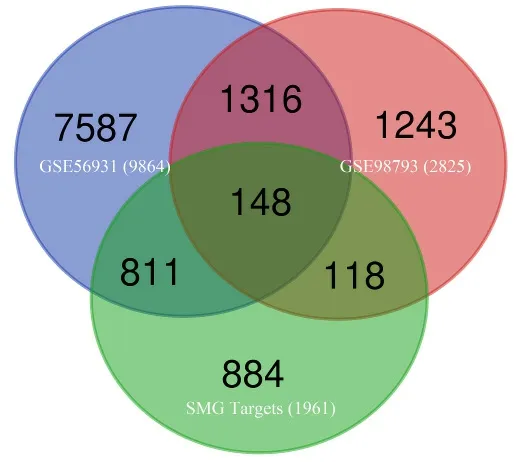
Figure 2 Venn analysis of SMG in treating depression
3.4 The protein-protein interaction (PPI) network construction of SMG in treating depression
The candidate targets were input into STRING to obtain the protein-protein interaction between the two targets.Moreover, interaction results were introduced to Cytoscape, removing the targets with low connection of primary network, and 121 nodes and 377 edges targets left (Figure 3).In this network, nodes represented targets, the larger the nodes and the darker the color was illustrated as the more crucial target.Moreover,edges represented the connection between two proteins,the wider the edges and darker the color was illustrated as the more strengthened connection.

Figure 3 The protein-protein interaction (PPI) network of SMG in treating depression.(A) Top 20 pathway of KEGG enrichment, (B) Top 20 biological processes.
3.5 The KEGG pathway enrichment and GO enrichment analysis of SMG in treating depression
As a result, 41 KEGG pathways, 224 biological processes pathways, 53 cellular components pathways and 33 molecular functions pathways of GO enrichment were screened out.The obvious unrelated KEGG pathways were deleted, for instance "pathways in cancer", "malaria", "microRNAs in cancer" and"tuberculosis".The top 20 pathways were diagrammed as bubble plots with R language (Figure 4).As Figure 4A showed, FoxO signaling pathway, cAMP signaling pathway and calcium signaling pathway were the crucial pathways of SMG in treating depression.In these pathways, FoxO signaling might be one of the most significant pathways consisting of the most targets (12 targets, IL10, TGFB2, CREBBP, INSR,AKT3, PRKAG2, ATM) and the lowest P-value (P =8.86E-03).As for GO enrichment, biological processes mainly related to positive regulation of nitric oxide biosynthetic process and response to hypoxia, cellular component was bind to extracellular space, exosome,surface, and apical plasma membrane, and molecular function were associated with protein binding, iron ion and ATP binding.
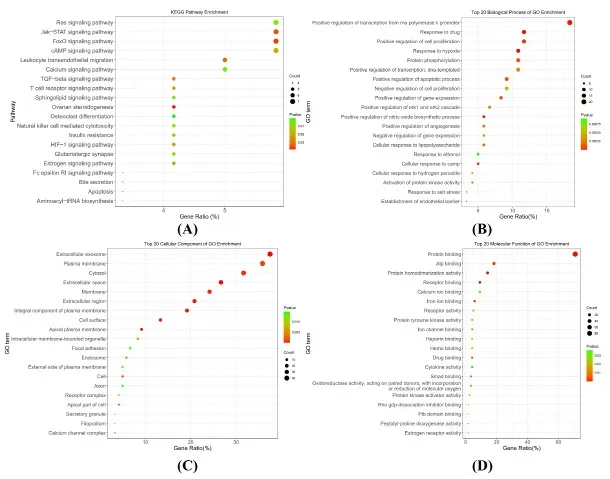
Figure 4 The functional analysis of SMG in treating depression.
3.6 The herbs-compounds-targets-pathways (H-CT-P) network construction of SMG in treating depression
All the herbs, compounds, targets and pathways were introduced into Cytoscape to construct the H-C-T-P network (Figure 5).The H-C-T-P network consisted of 601 nodes (17 herbs, 444 compounds, 120 targets and 20 pathways) and 2168 edges.Further, 65 compounds(the top 20 compounds were shown in Table 1, details of 65 compounds were shown in supplementary table S1), 18 targets (Table 2) and 3 pathways (Table 3)were considered as core nodes according to topological properties.As summarized in Table 1, caprylic acid,lauric acid, nootkatone and carvone might show their importance of SMG.Additionally, VDR, TNF, GPER1,HSP90AA1 with higher properties, play a significant role in SMG in treating depression via regulating deprived circadian rhythms.

Table 2 The degree, closeness centrality (CC), betweenness centrality (BC) of key targets of SMG in treating with depression.

Table 3 The degree, closeness centrality (CC), betweenness centrality (BC) of key pathways for SMG in treating with depression.
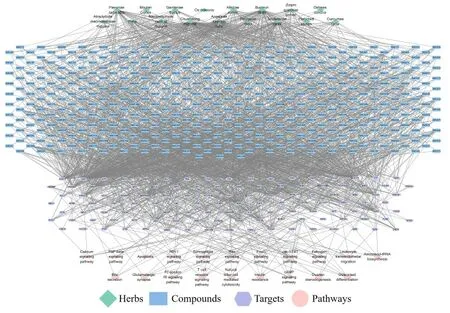
Figure 5 The herbs-compounds-targets-pathways (H-C-T-P) network of SMG in treating depression.
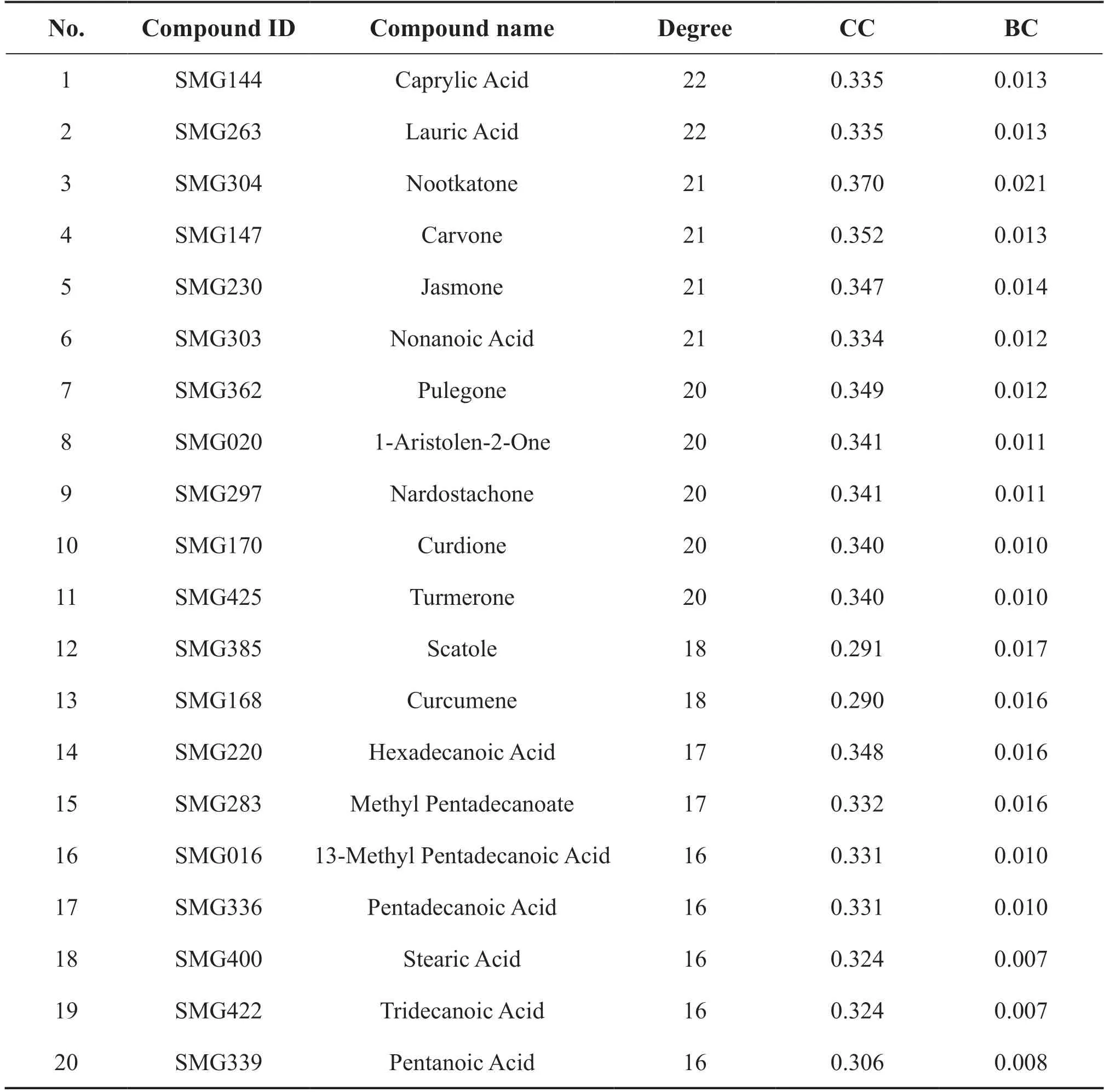
Table 1 The degree, closeness centrality (CC), betweenness centrality (BC) of top 20 core compounds of SMG in treating with depression.

?
3.7 Docking result
To further reflect the binding connection between core proteins and compounds, molecular docking was introduced in the study.Three core compounds,including carvone (SMG147), jasmone (SMG230),nootkatone (SMG147) and three core targets (VDR,TNF, IL10), were carried out for molecular docking(Table 4).The details of binding sites are presented in Figure 6.In addition, it was demonstrated that the active site of the compound bounds to the target implied the compound-target interaction of SMG in treating depression.
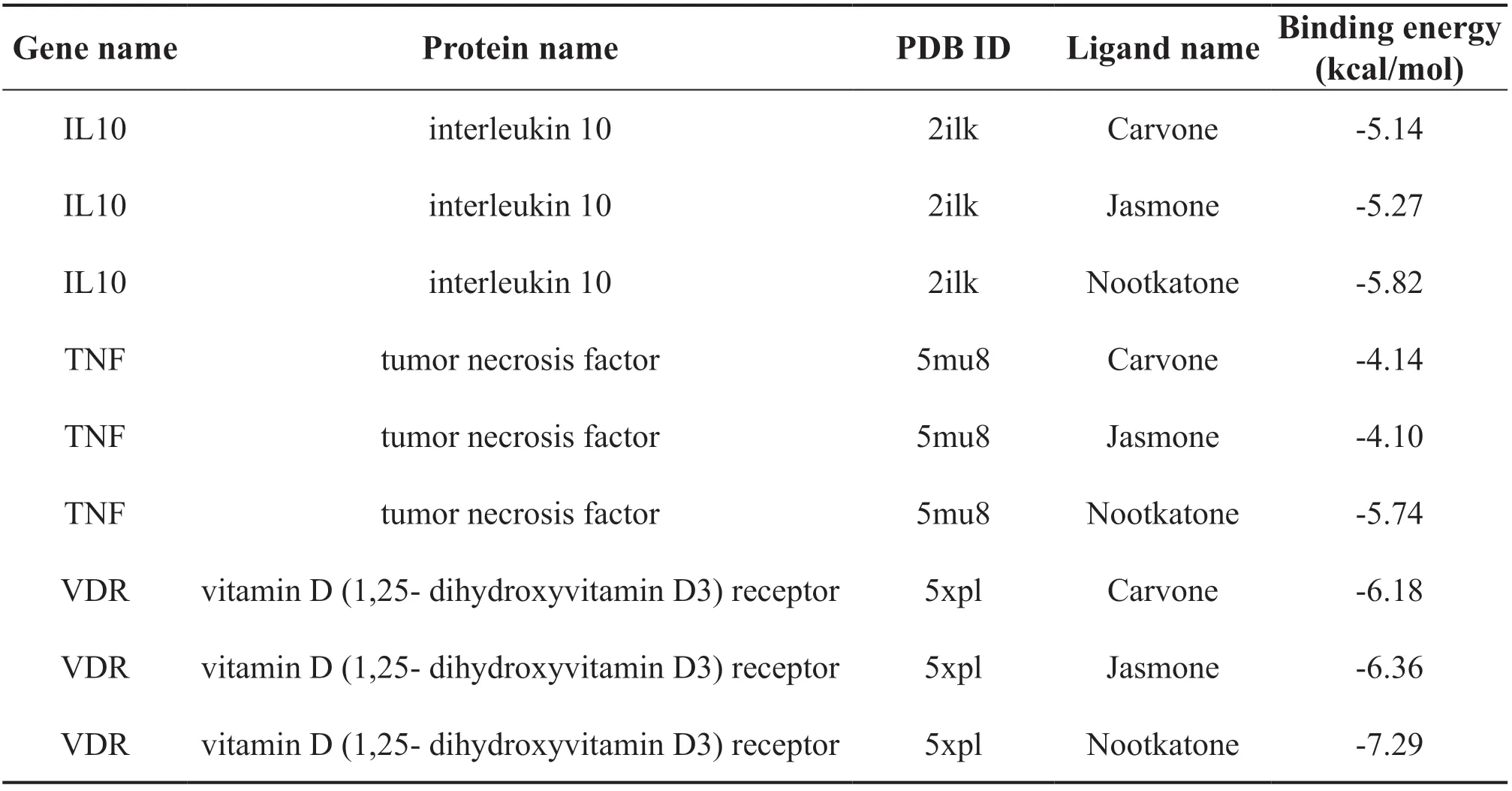
Table 4 The molecular docking result between core targets and compounds for SMG in treating with depression.
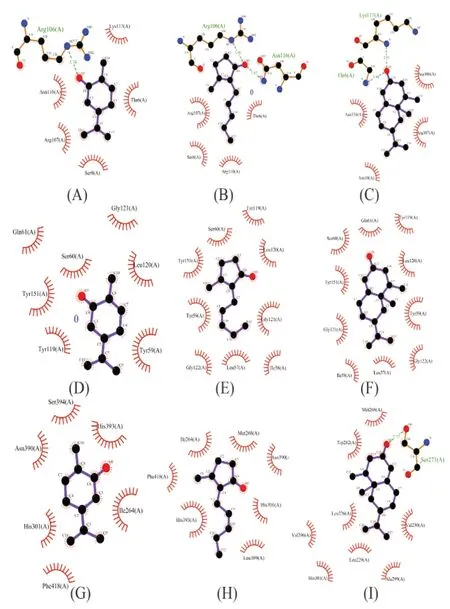
Figure 6 The docking simulation between core targets and core compounds.(A) IL10 and Carvone, (B)IL10 and Jasmone, (C) IL10 and Nootkatone, (D) TNF and Carvone, (E) TNF and Jasmone, (F) TNF and Nootkatone, (G) VDR and Carvone, (B) VDR and Jasmone, (C) VDR and Nootkatone.
4 Discussion
In the present study, we integrated network pharmacology approach and gene expression profiling,and revealed that 65 compounds, 18 targets and 3 pathways of SMG concerning circadian rhythms in treating depression.As the compound results presented,Chuan xiong (Chuanxiong Rhizoma) and Chai hu(Bupleuri Radix) were two of the significant herbs in SMG since these herbs contain most compounds.Chuanxiong rhizome consisted of phenols, organic acids (such as ferulic acid), phthalides (such as ligustilide), alkaloids (such as ligustrazine), and polysaccharides [28, 29].Current research has indicated that chuanxiong rhizome possesses anti-inflammatory,neuron protection, improvement of cerebral blood supply [28].Tetramethylpyrazine is a natural compound with neuroprotective effects that exist in chuanxiong rhizome; study had proved its neuroprotective effects for depression through TLR4-NF-kB-NLRP3 signaling pathway in the brain [30].Traditionally, radix bupleuri is a valuable medicinal plant in treating mood disorders.Researches have shown that saikosaponin D of bupleuri radix antagonized UCMS-induced depressive behaviors in rats, which was mediated, partially, by the enhancement of HPA axis function and consolidation of hippocampal neurogenesis [31].Our hub-network analysis and docking result suggested that carvone plays a significant role in SMG in treating depression associated with circadian rhythm.A previous study indicated that carvone has a depressant effect on the central nervous system, potentiating pentobarbital sleeping time [32].The further study proved that carvone decreased spontaneous locomotor activity in the sleep deprivation experiment [33], which confirmed our hypothesis.Lauric acid, also known as dodecanoic acid, is one of the most important SMG compounds in treating depression owning the highest degree value(DC = 22).An integrated meta-analysis comparing peripheral blood metabolites of healthy individuals and major depressive disorder (MDD) patients explored that MDD patients were characterized by higher levels of dodecanoic acid, which indicated that dodecanoic acid might be one of biomarkers for MDD [34].Nootkatone is a kind of sesquiterpenes and is regarded as a crucial part of components of Chinese herbs, like Bupleuri radix.The latest study provided evidence and suggested that nootkatone has a significant antidepressant effect through modulation of oxidative stress induced by D-galactosamine administration [35].Of note, catechin,as another core compound of SMG, has been proved to decrease depressive symptoms in experimental animals,in part, possibly linked to the inhibition of monoamine oxidase (MAO) [36, 37].
At the protein level, tumor necrosis factor (TNF)and interleukin 10 (IL10) with higher topological properties were two of the core cytokines for SMG,which had defined evidence in depression [38].Our previous clinical research proved that SMG could effectively improve sleep, alertness, plus anxiety and depression symptoms in shift nurses, and the changes were associated with salivary cytokine levels of TNF,IL1B IL6 and IL10 [11].Recent pieces of evidence have also shown the bidirectional communication between the immune system and the circadian rhythms[39, 40], and evidence strongly indicated that TNFα functions as a bridging element between the circadian clock and immune system [41].Furthermore, numerous studies have suggested that major depression is accompanied by immune dysregulation and activation of the inflammatory response system (IRS), which has been demonstrated by increased production of proinflammatory cytokines such as IL1B, IL-2, IL-6, interferon (IFN)-β, TNF-α [42-44].Overall, SMG might regulate TNF and IL10 levels to restore the disrupted circadian of depression.In addition, VDR(vitamin D (1,25-dihydroxyvitamin D3) receptor) as an essential pathological target in depression showed the highest connectivity with compounds.As known,vitamin D deficiency has been related to an increased risk of mental health problems (like depression) and individual responses to stress, which is linked to mitochondrial function and the formation of serotonin[45].Research demonstrated that maintaining adequate concentrations of serum vitamin D might have a protective effect against depression through inducing the expression of the gene of tryptophan hydroxylase 2 (TPH2), the expression of serotonin reuptake transporter (SERT) as well as the levels of monoamine oxidase-A (MAO-A) [46].
Moreover, VDR could alter the expression of circadian genes in adipose-derived stem cells [47],which convinced the interrelation between VDR and the circadian system.Interestingly, vitamin D has been proposed as a modulator of the sleep-wake cycle since low hormone levels were correlated with short sleep duration.VDR could enter the mitochondrion to regulate mitochondrial function directly [48].Hence, VDR may play a potential target of SMG to synchronize circadian rhythms of depression.
KEGG analysis results suggested that cAMP signaling pathway and calcium signaling pathway played an important role in SMG in treating depression.The potential role is well known to FoxOs in regulating mood-relevant behavior [49], and recent studies have shown that FoxO is implicated in the pathogenesis of depression through regulating neural morphology,synaptogenesis, and neurogenesis in the hippocampus[49, 50].cAMP signaling pathway affects various biological processes in the nervous system, involved in neural regeneration, synaptic plasticity, memory formation, and neuronal functions [51].Studies indicated that sleep deprivation impaired cAMPdependent forms of synaptic plasticity signaling in the hippocampus partly through enhanced phosphodiesterase-4 (PDE4) activities [52].In other words, the cAMP signaling pathway may connect the sleep deprivation-induced disrupted circadian and depression, which might establish possible therapeutic pathways for managing the depressive disorder.Additionally, it was reported that a genetic variation in the calcium/calmodulin pathway had been linked to depression [53] through inputting a small amount of calcium at high frequencies or at lower frequencies as a larger amount to induce the same activation of CaMKII[54].Moreover, both genome-wide association studies and analysis of de novo mutations in CaV1.2 channels showed significant overlap for major depression [55].
Several limitations need to be considered for this study.Firstly, the identification of effective compounds was based on databases instead of liquid chromatography-mass spectrometry (LC-MS/MS) method, which may remain bias.Secondly,this study was restricted to an in-silico analysis which was qualitative and narrative.Thirdly, it was preliminary findings that explored the mechanism of SMG in treating depression and lacking experimental verification.
Despite these limitations, our study investigated the formula SMG for the active compounds, potential targets, and pathways, hence, the SMG molecular mechanisms for the management of depression via regulating the disrupted circadian rhythms.We proposed a systematic idea for the future confirmation of the exact mechanism of SMG.
5 Conclusion
To sum up, our research firstly investigated the risky genes of depression that circadian rhythm reduced by gene expression profiling, and network pharmacology approach was introduced to explore the mechanism of SMG in treating depression via regulating disrupted circadian rhythms.Conclusively, 65 compounds,18 targets and 3 pathways were obtained, SMG in treating depression by regulating disrupted circadian rhythms linked to core targets TNF, IL10, VDR in FoxO signaling pathway, cAMP signaling pathway and Calcium signaling pathway.Ultimately, the present study established a possible mechanism of SMG for the management of depression through identifying the active compounds, risky targets and potential pathways.

No.Compound ID Compound name Degree CC BC 1 SMG144 Caprylic Acid 22 0.3354 0.013 2 SMG263 Lauric Acid 22 0.3354 0.013 3 SMG304 Nootkatone 21 0.3697 0.0214 4 SMG147 Carvone 21 0.3523 0.0133 5 SMG230 Jasmone 21 0.347 0.0135 6 SMG303 Nonanoic Acid 21 0.3343 0.0115 7 SMG362 Pulegone 20 0.3494 0.0116 8 SMG020 1-Aristolen-2-One 20 0.3407 0.0108 9 SMG297 Nardostachone 20 0.3407 0.0108 10 SMG170 Curdione 20 0.3396 0.0099 11 SMG425 Turmerone 20 0.3396 0.0099 12 SMG385 Scatole 18 0.2911 0.0168 13 SMG168 Curcumene 18 0.2897 0.0164 14 SMG220 Hexadecanoic Acid 17 0.3478 0.0158 15 SMG283 Methyl Pentadecanoate 17 0.332 0.0115 16 SMG016 13-Methyl Pentadecanoic Acid 16 0.3313 0.0091 17 SMG336 Pentadecanoic Acid 16 0.3313 0.0091 18 SMG400 Stearic Acid 16 0.3238 0.0065 19 SMG422 Tridecanoic Acid 16 0.3238 0.0065 20 SMG339 Pentanoic Acid 16 0.3063 0.0083 21 SMG088 Albizzin 16 0.2996 0.0143 22 SMG262 L-Albizziine 16 0.2996 0.0143 23 SMG418 Thymol 13 0.3431 0.0122 24 SMG104 Angelicin 12 0.381 0.0286 25 SMG309 O-Cresol 12 0.3419 0.0108 26 SMG312 O-Ethylphenol 12 0.3295 0.0091 27 SMG401 Stigmasterol 11 0.3715 0.027 28 SMG155 Cetylic Acid,Hexadecanoic Acid,Palmitic Acid 10 0.3523 0.0142 29 SMG269 Linolenic Acid 9 0.332 0.0062 30 SMG156 Choline 9 0.3123 0.0093 31 SMG118 Beta-Elemene 8 0.3186 0.0046 32 SMG417 Tetradecane 8 0.3186 0.0046 33 SMG099 Alpha-Pinene 8 0.3053 0.0035 34 SMG139 Camphene 8 0.3035 0.003 35 SMG151 Catechin 8 0.292 0.0043 36 SMG394 Sitosterol,Sitosterol 7 0.3617 0.0157 37 SMG260 Kaempferitrin 7 0.3127 0.0053 38 SMG265 Lignoceric Acid 7 0.3047 0.0028 39 SMG287 Myrcene 7 0.3038 0.0027 40 SMG086 Adenine 7 0.3002 0.0074 41 SMG180 Dihydrobaicalin 7 0.2981 0.0026 42 SMG320 Oroxylin A 7-O-Glucuronide 7 0.2981 0.0026 43 SMG440 Wogonoside 7 0.2981 0.0026 44 SMG337 Pentadecanol 7 0.2934 0.0038 45 SMG290 Myrtanol 7 0.2906 0.0024 46 SMG302 N-Nonanol 7 0.2906 0.0024
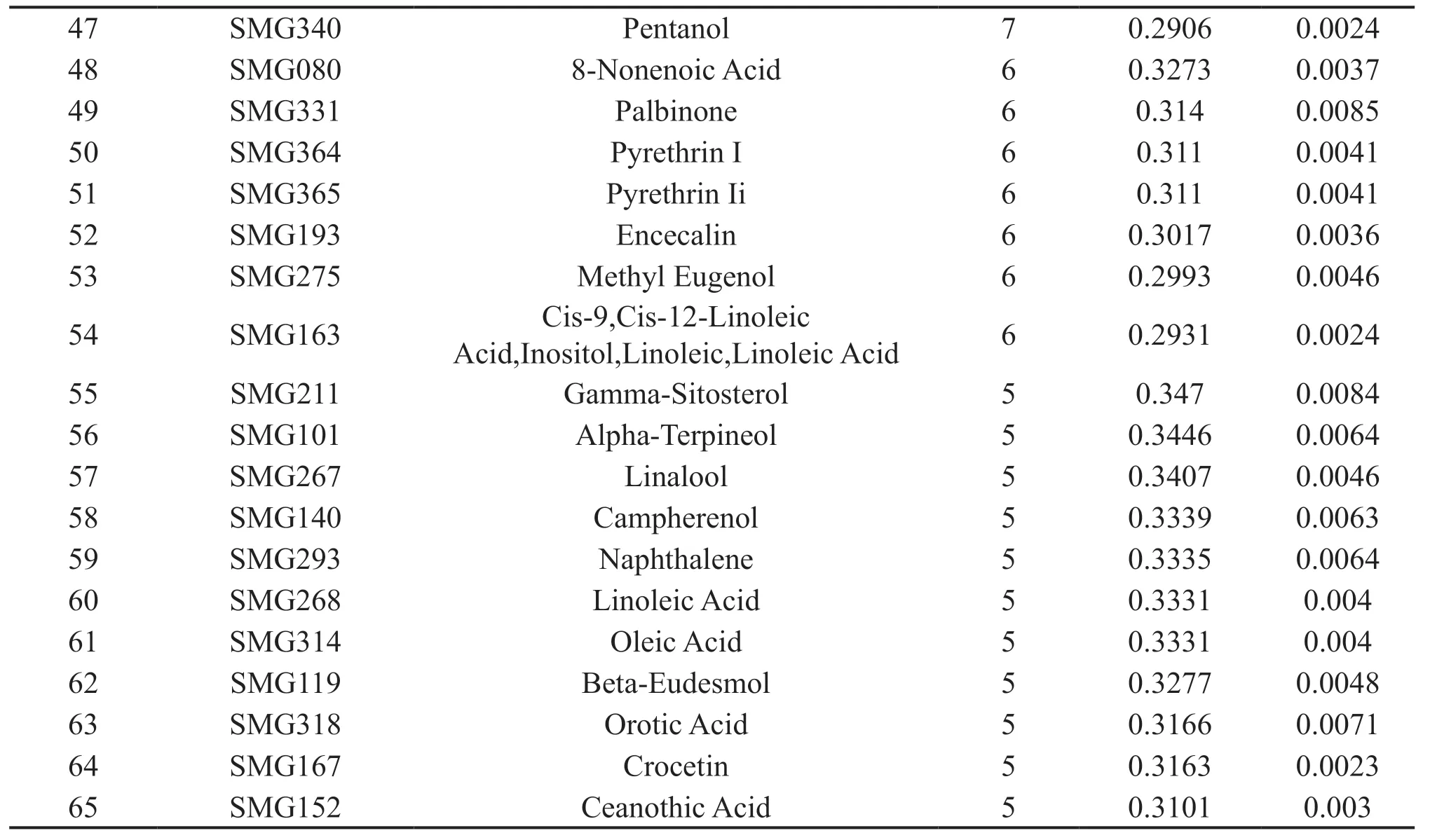
Supplementary Table S1 The degree, closeness centrality (CC), betweenness centrality (BC) of core compounds of SMG in treating with depression
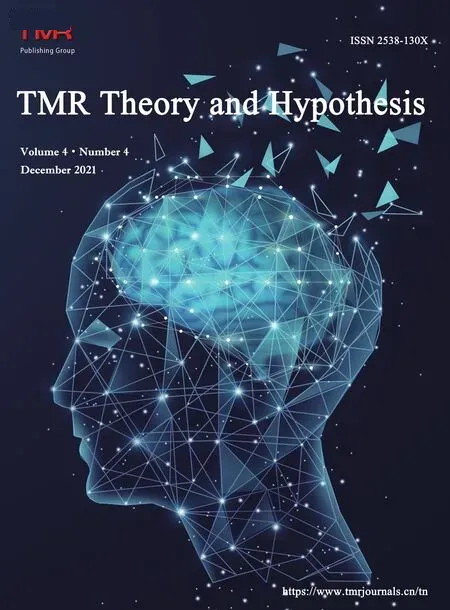 Medical Theory and Hypothesis2021年4期
Medical Theory and Hypothesis2021年4期
- Medical Theory and Hypothesis的其它文章
- Hypothesis on how Distance External Qi Therapy works
- Observation of the clinical effects of catgut implantation at acupoints on postpartum obesity with insulin resistance
- SARS-CoV-2 And The Gastrointestinal Disorders
- CiteSpace-based Knowledge Graph Analysis of the Current Status and Trends of Chinese Medicine Research in Idiopathic Membranous Nephropathy
